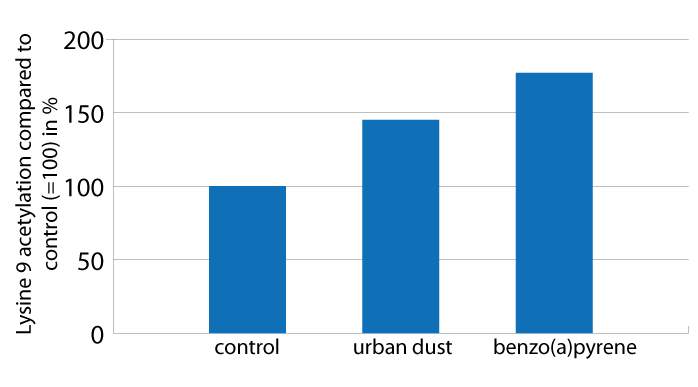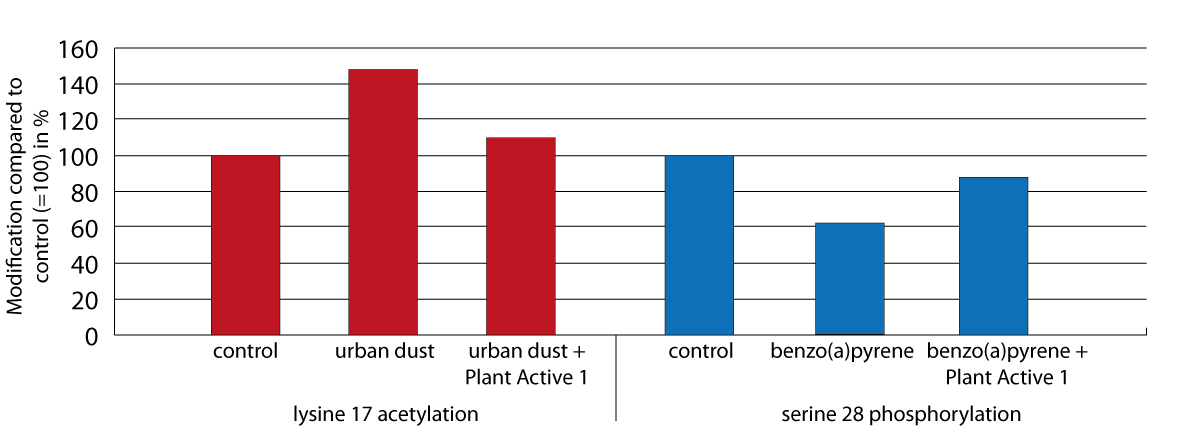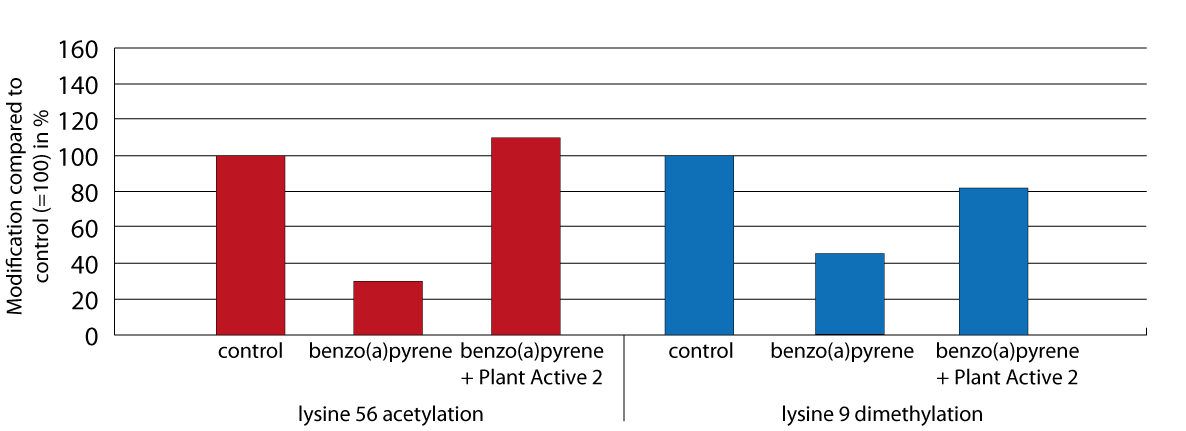Pollution and epigenetics: Histone H3 modifications in keratinocytes after exposure to urban dust and Benzo(a)pyrene
IFSCC 2018, 30th congress, Munich
Daniel Schmid (1), Franziska Wandrey (1), Fabienne Guyard (2), Samuel Geunin (2), Fred Zülli (1)
(1) Mibelle Biochemistry, Mibelle AG, Buchs, Switzerland
(2) Bioalternatives SAS, Gencay, France
Introduction
Pollutants like particulate matter, polycyclic aromatic hydrocarbons and gases such as ozone, nitrogen dioxide or sulfur dioxide are responsible for allergies and respiratory diseases but also a cause for increased mortality. Induction of oxidative stress and activation of inflammatory pathways are regarded as the main biological mechanisms involved.
Epigenetics, which studies modulation of gene expression caused by mechanisms other than changes in the DNA sequence, can explain how environmental factors influence our body. Whereas oxidative stress acts at the moment, epigenetic modification may lead to a long term effect, even when the environmental stress is not present anymore. This is the reason why air pollution should be analyzed for epigenetic effects.
The histone proteins are responsible for the packaging and organization of the DNA. Modifications of histone proteins define the access of transcription factors to the DNA and thus whether a gene is active or not. Recent studies showed air pollution-induced modifications of the histone H3 protein.
Air pollution also affects our skin which is especially exposed.Pollution can lead to allergic skin conditions, acne, uneven pigmentation and in general premature skin aging. In this work, human epidermal keratinocytes were used to study the effects of urban dust and benzo(a)pyrene on the epigenetic pattern of the histone H3 protein. The assay was then used to screen a series of plant extracts in order to find cosmetic actives to protect the skin against air pollution.
Materials and Methods
Cultures and treatments
Normal human epidermal keratinocytes (2nd passage) were seeded in 175 cm2 flasks (125 000 cells) and cultured in Keratinocyte-SFM supplemented with EGF (0.25 ng/ml), pituitary extract (25 μg/ml) and Gentamycin (25 μg/ml) for 24 hours. The medium was then replaced with culture medium containing or not (control) the pollutants and the test compounds. The urban dust (Ref. NIST, Standard Reference Material (SRM) 1649b) was used as stock solution (100 mg/ml in ethanol/water, 2:1) at 0.01 mg/ml in the culture medium. Cells were then subcultured from 2nd to 6th passage every week with treatment after each subculture. At the 7th passage, the cells were seeded in 12-well plates (350 000 cells/well) and the treatment was renewed. Cells were the incubated for 24 hours. At the end of the incubation, the medium was discarded and the cells were washed in phosphate buffered saline (PBS) solution.
Quantification of histone modifications
The quantification of total histone H3 and 21 histone H3 modifications was performed using the EpiQuick Histone H3 Modification Multiplex Assay Kit (Colorimetric) from Epigentek (Ref. P-3100-96) following the supplier’s instructions. For each experimental condition, 100 ng of total histone extract was deposited per well.
Conclusions
The results presented here show epigenetic effects of pollution on keratinocytes analyzed at the histone H3 protein. Further it could be demonstrated that certain plant extracts could prevent those epigenetic effects and thus could be used for a sustainable, long term protection of the skin against pollution.
Results and Discussion
Exposure of the keratinocytes to urban dust or benzo(a)pyrene was found to strongly modulate methylation, acetylation or phosphorylation at almost all of the analyzed 21 histone H3 sites. It was also possible to reproduce the results of Ding et al. (Environmental Toxicology and Pharmacology, vol 42, 2016) which showed increased acetylation at lysine 9 in rats after exposure to traffic-related air pollution. There was a clear increase in lysine 9 acetylation in keratinocytes after exposure to urban dust and benzo(a)pyrene.
There were two plant extracts that clearly demonstrated neutralizing effects regarding the histone modifications. The Plant Active 1 could antagonize the effect of urban dust at lysine 17 and the effect of benzo(a)pyrene at serine 28.
The Plant Active 2 was especially effective in neutralizing the effects of benzo(a)pyrene. It antagonized completely the reduced acetylation at lysine 56 and the reduced dimethylation at lysine 9.
Check out Bioalternatives’ updates and experience new testing ideas
- Bioassays, models and services
- Posts and publications
- Events










